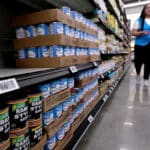
Everyone loves a good deal, right? So then why are fewer shoppers seeking them out?
Whether it’s a sign of an improving economy, deal-searching fatigue, or a decline in the number of deals being offered, a new report says more grocery shoppers are buying what they want, whatever the price.
That insight comes from TABS Analytics’ sixth annual Food and Beverage Consumables Study, which examines the grocery shopping, spending and saving habits of American consumers.
“Deals are very important to a wide range of shoppers,” the report found, with 38% of those surveyed saying they use three to five different “deal tactics” such as using coupons, consulting store circulars or choosing to shop at a discount store. 24% use six or more tactics.
But both of those percentages have been declining in recent years. Back in 2013, the first year of the annual survey, 41% used three to five deal tactics and 31% used six or more.
So why the decline?
“People seem less inclined to bounce from store to store to get a deal, favoring convenience instead,” the report found. Households with kids saw the steepest decline in deal-searching activity, dragging down the overall average. “This could signal an emerging story with this group of buyers, who may be favoring convenience over price now,” TABS noted.
As in years past, the most-used deal tactic is a passive one – seeking out stores with everyday low prices, like Walmart or ALDI. 63% of shoppers favor this tactic.
Strangely enough, one deal tactic that you might think is on the rise, seems to be stagnating – and two tactics that would seem to be falling out of favor, are actually increasing in usage.
Statistics show that more and more digital coupons are being used these days. But TABS found that the percentage of shoppers who reported using them increased only a single point from last year, to 33% – which is well below 2013’s high of 38%. Curiously, and despite predictions that the shift from paper to digital is inevitable and is already happening, TABS concluded that digital coupons “are still not gaining traction”.
Maybe because its findings indicate that good old-fashioned paper doesn’t seem to be losing traction. Consulting store circulars is now the number-two deal tactic, used by 45% of shoppers, up from 40% last year. TABS even admits that it’s “unclear why this tactic has risen in popularity among both young purchasers and the general population”. And even though paper coupon use is down significantly from a high of 45% in 2013, it ticked upward to 33% from last year’s low of 31%.
So are paper circulars and paper coupons poised for a big comeback? Don’t count on it. Older shoppers may like them, but TABS’ findings indicate that younger shoppers just aren’t interested. “There is a huge gap in use of (paper coupons) and circulars from younger shoppers compared to the general population,” TABS’ report found. “That does not bode well for the future of those two vehicles,” TABS CEO and founder Kurt Jetta said.
Still, it’s unclear whether younger shoppers’ preferences will change as they get older. Shoppers aged 18-34 lagged behind older shoppers in nearly all deal-seeking categories – possibly because many of them are single and not doing much grocery shopping or deal-seeking. Once they get older and have families, easily-accessible paper circulars and coupons might prove more difficult to resist.
There’s an argument to be made that deal-seeking is on the decline not because shoppers are too rich to care about saving money anymore, but because there are fewer deals to be had. Back in 2016, Jetta warned that “manufacturers and retailers are pulling back on deep discounts and are opting for watered-down promotions”. And weaker promotions, he said, “are directly correlated to weaker sales”.
Because deal shoppers, TABS argues, are better shoppers. “There is a definite cause and effect between higher deal usage and higher purchase activity,” TABS found. “Greater use of any type of deal tactic results in more purchases.” 40% of shoppers identified as “heavy deal users” are also heavy buyers. “So even though retailers may claim that they want to boost engagement or other factors to increase sales, it’s clear that deals should be a fundamental part of the equation,” TABS concluded.
So ultimately, it could be argued that shoppers aren’t abandoning deals – rather, the deals are abandoning them. Shoppers “like deals. it’s one of the most fundamentally important aspects of their shopping trip,” Jetta said. “You hear about overall price, convenience, location, variety, engagement, they want to love their brands – no, they want deals.”
And retailers and brands would be wise to provide them if they want our business. Otherwise, shoppers may start looking for deals – somewhere else.















